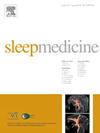日本嗜睡症的医疗负担:日本医疗数据中心对医疗保险索赔的回顾性分析。
IF 3.8
2区 医学
Q1 CLINICAL NEUROLOGY
引用次数: 0
摘要
背景:发作性睡病是一种需要终生治疗的慢性疾病;然而,很少有研究评估发作性睡病的疾病负担。我们使用日本医疗数据中心健康保险索赔数据库的数据估计了日本发作性睡病的医疗负担。方法:回顾性分析2014年1月1日至2019年12月31日发现的发作性睡病病例和匹配对照的临床负担、医疗资源利用和成本。结果:1317例病例中;889例(1778例对照)分析了医疗负担,626例(1252例对照)分析了临床旅程,439例(无对照)分析了治疗模式。最常见的基线合并症是非发作性睡症睡眠障碍(41.6%对3.0%对照),包括失眠(28.5%对2.6%)和睡眠呼吸暂停(10.8%对0.3%;结论:在日本,发作性睡病具有严重的合并症负担、高药物处方率和高医疗资源使用率。本文章由计算机程序翻译,如有差异,请以英文原文为准。

Healthcare burden of narcolepsy in Japan: A retrospective analysis of health insurance claims from the Japan Medical Data Center
Background
Narcolepsy is a chronic disorder that requires lifelong management; however, few studies have evaluated disease burden of narcolepsy. We estimated the healthcare burden of narcolepsy in Japan using data from the Japan Medical Data Center health insurance claims database.
Methods
This was a retrospective analysis of clinical burden, healthcare resource utilization, and costs among incident narcolepsy cases and matched controls identified between January 1, 2014 and December 31, 2019.
Results
Of the 1317 incident cases; 889 (with 1778 controls) were analyzed for healthcare burden, 626 (with 1252 controls) for clinical journey, and 439 (no controls) for treatment patterns. The most common baseline comorbidity was non-narcolepsy sleep disorder (41.6 % cases vs 3.0 % controls), including insomnia (28.5 % vs 2.6 %) and sleep apnea (10.8 % vs 0.3 %; both p < 0.001). The most common nonsleep disorder comorbidities were depression (35.0 % vs 2.6 %), anxiety (30.4 % vs 2.7 %), and headache/migraine (18.1 % vs 5.5 %; all p < 0.001). Compared to controls, narcolepsy cases had more prescription claims in the year following index date (82.8 % vs 9.5 %; p < 0.001), higher rates of outpatient (2291.8 vs 674.9 visits/100 person-years; p < 0.001) and inpatient claims (56.8 vs 5.1/100 person-years; p < 0.001), and longer hospital stays (mean 2.9 vs 0.5 days; p < 0.001). Similarly, median HCRU costs were higher in cases than controls (total annual healthcare costs, $2531 vs $266; community pharmacy claims, $826 vs $47 per person; and outpatient claim costs, $1053 vs $188 per person year).
Conclusions
Narcolepsy carries a substantial comorbidity burden, a high rate of medication prescribing, and high healthcare resource use in Japan.
求助全文
通过发布文献求助,成功后即可免费获取论文全文。
去求助
来源期刊

Sleep medicine
医学-临床神经学
CiteScore
8.40
自引率
6.20%
发文量
1060
审稿时长
49 days
期刊介绍:
Sleep Medicine aims to be a journal no one involved in clinical sleep medicine can do without.
A journal primarily focussing on the human aspects of sleep, integrating the various disciplines that are involved in sleep medicine: neurology, clinical neurophysiology, internal medicine (particularly pulmonology and cardiology), psychology, psychiatry, sleep technology, pediatrics, neurosurgery, otorhinolaryngology, and dentistry.
The journal publishes the following types of articles: Reviews (also intended as a way to bridge the gap between basic sleep research and clinical relevance); Original Research Articles; Full-length articles; Brief communications; Controversies; Case reports; Letters to the Editor; Journal search and commentaries; Book reviews; Meeting announcements; Listing of relevant organisations plus web sites.
 求助内容:
求助内容: 应助结果提醒方式:
应助结果提醒方式:


